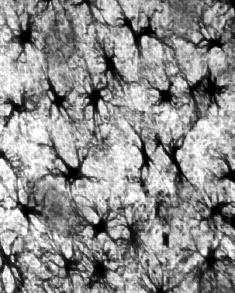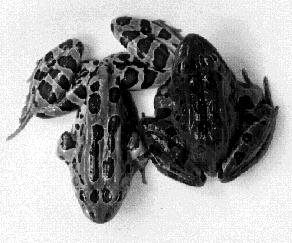
Melanocyte-stimulating hormone gets its name because of its effect on melanocytes: skin cells that contain the black pigment, melanin. In humans, melanocytes are responsible for moles, freckles, and suntan.
In most vertebrates, MSH is produced by an intermediate lobe of the pituitary gland. Its secretion causes a dramatic darkening of the skin of fishes, amphibians, and reptiles. The darkening occurs as granules of melanin spread through the branches of specialized melanocytes called melanophores.
The photomicrograph on the right shows melanophores in the skin of a frog with the melanin dispersed throughout the branches of the cells. This effect is produced by MSH. When the pigment retreats to the center of the cells, the skin lightens.
The photo below was taken a few moments after the frog on the right was injected with a small dose of MSH.
The same precursor molecule from which the adrenocorticotropic hormone (ACTH) is synthesized also produces two forms of MSH. In fact, alpha-MSH is identical to the first 13 amino acids at the amino terminal of ACTH.

Humans have no intermediate lobe in their pituitary gland, and MSH may not be a circulating hormone for us. However, researchers at the University of Arizona have shown that alpha-MSH can cause darkening of human skin. With FDA approval, they injected male volunteers with a synthetic version of alpha-MSH - which they called Melanotan I - to see if their skin darkened. It did, raising the possibility of using melanotan to get a suntan without the risks of exposure to ultraviolet light.
A second synthetic version of MSH - dubbed Melanotan II, also darkened the skin of male volunteers. Unexpectedly, it also caused many of them to develop penile erections. This has raised the possibility of using MSH to cure impotence.
| Welcome&Next Search |